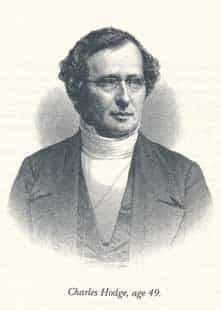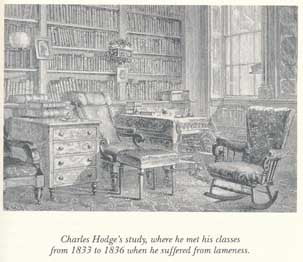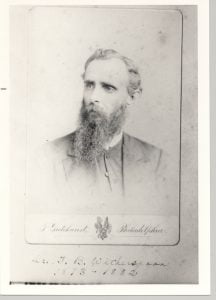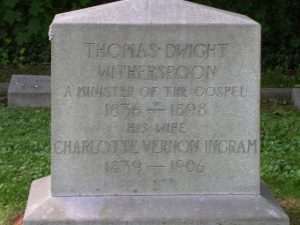John Calvin died on May 27th, in the year 1564. The following article, though quite long, seems appropriate to post at this time. Tomorrow we will run the second part of the article. The following, its title aside, forms a nice, succinct summary of the life and ministry of John Calvin. And as to “reconstruction,” I’ll admit to having never closely studied the whole matter of theonomy, but the title alone of this article raises questions as to the origin of, or rather, the theological application of the term “reconstruction”. At what point was the word first used in a theological sense?
John Calvin, the World Reconstructionist
By the Late Rev. James Mitchell Foster, D.D.
(Revised and Edited by his Daughter)
[Christianity Today 6.8 (January 1936): 173-178.]
[Reverend James Mitchell Foster, D.D., was pastor of the Second Reformed Presbyterian Church of Boston, Massachusetts, for 37 years exactly, from his ordination, a Sabbath afternoon, November 11, 1891, to the day of his death, a Sabbath afternoon, November 11, 1928. He was killed almost instantly by an automobile soon after he had left his church, so that it was said of him at his funeral service, “He stepped from the pulpit into Heaven.”]
IN THESE days of Dictators with standing armies, greater navies, and air forces of increasing size, is it not timely to turn our thoughts to John Calvin, whose work in Geneva produced an efficient, orderly and prosperous civil polity ruled “not by might nor by power, but by My Spirit, saith the Lord of Hosts”? The old aphorism of the historians that the history of the world cannot be understood apart from the government of the world is a tribute to Calvinism. History is God’s plan of governing the world in which He moves towards a perfect order as the goal of the human race.
John Calvin had a little city. Geneva had only 20,000 people. But he gave an object lesson for all the world. It was not the size but the kind of temple he built that counted—like a little leaven that leaveneth the whole. He ceased from his labors and fell asleep May 27, 1564, as Beza remarks, just as the sun was setting. But the sun will never set on Calvinism. The Huguenots kept Calvinism alive in France until it produced the Republic. William the Silent and the reformers established Calvinism in the Netherlands as the Dutch Republic. Knox established Calvinism in Scotland, Cromwell and William Prince of Orange made England by Calvinism. The Pilgrims and the Puritans of England, the Presbyterians of Ireland, the Covenanters of Scotland brought Calvinism to America.
Candid judges, like Mark Pathson, have written: “In the sixteenth century Calvinism saved Europe”; like Bancroft, “He that will not honor the memory and respect the influence of Calvin knows little of the history of American liberty”; like John Morley, “To omit Calvin from the forces of Western evolution is to read history with one eye shut.” “Calvin shaped the mould in which the bronze of Puritanism was cast.” In a lecture by James Anthony Froude before the students of St. Andrew’s University on Calvinism, Dr. Froude accentuated the fact that Calvinism has produced some of the world’s greatest men. “It is enough to mention the names of William the Silent, of your own Knox and Andrew Melville, and the Regent Murray, of Coligny, of our English Cromwell, of Milton, of John Bunyan. These men were possessed of all the qualities which give nobility and grandeur to human nature — men whose life was as upright as their intellect was commanding and their public aims untainted with selfishness: unalterably just where duty required them to be stern, but with the tenderness of a woman in their hearts; frank, true, cheerful, humorous, as unlike sour fanatics as it is possible to imagine anyone, and able in some way to sound the keynote to which every brave and faithful heart in Europe instinctively vibrated.”
John Calvin was a man of poverty — like Jesus of Nazareth. He left only $200 at his death but he had hewed Plymouth Rock from the Alps of divine truth. And Calvinism will yet give civil and religious liberty to all nations and kindreds and tongues and peoples, because Calvinism is God’s order for the sons of men upon earth. And when Calvinism has become triumphant in all nations, Abraham’s vision will be realized.
On October 31, 1517, when Calvin was eight years old, Luther nailed his 95 theses to the door of Wittenberg Castle Church. The sound of that hammer was heard through all Europe. Luther and Zwingli and Melancthon were iconoclasts rather than builders. A master-builder was needed for the constructive work of the Great Reformation. And God raised up John Calvin, French by birth, born and bred a Roman Catholic in God’s Providence, taken away from his native country because France would not have his reformation views, after trying in vain to find a hiding place, going about Savoy, to Bavaria, to Italy, and at last to Geneva, where, after being banished and recalled, he established a true Christian church and a true Christian state, according to the pattern shown him in the mount of God’s word.
The Providential Preparation of Geneva for Calvin
Geneva is situated at the end of Lake Leman, between the Jura and Alps Mountains. Caesar carried his conquests here and left Roman laws. After the breaking up of the Roman Empire, King Goudebald led his Burgundian Christian soldiers into this basin of the Rhone and brought freedom to Geneva in the 5th century. In 534 A. D. the Merovingian Kings of France seized and held Geneva until 888 A. D. when the second Burgundian Kingdom began there.
As early as 381 A.D. Geneva had a bishop. In 1091 A.D. we find one Aymon, Count of Geneva, at the helm. There was a conflict between the counts and bishops for supremacy. Peter of Savoy attempted to subjugate Geneva and failed in 1267. Twenty years later Amadeus of Savoy renewed the assault on Geneva and again it came to naught. In 1418, the Counts having become Dukes of Savoy, the Duke appealed to Pope Martin V to confer upon him the secular authority of Geneva. The syndics, counselors, and deputies of the municipal organization protested but the Pope acceded. In 1504, Charles III, Duke of Savoy, entered the struggle for the subjugation of Geneva, which had become characterized by its passion for independence and playing of one rival ruler against another. The struggle lasted for twenty years. The fairs at Geneva were destroyed and the prevalent distress of the 15th century became worse in the 16th. Finding that he could accomplish nothing by wily plots with the citizens themselves, he procured through the Pope Leo X the appointment of a scion of his own house (Savoy) as bishop, upon condition that the bishop should give the control of the city, so far as civil affairs were concerned, into the hands of the Duke. This resulted in a rebellion on the part of the citizens, which ultimately became a revolution, led by Berthelier, Pecotat and Bonivard, who in turn were subjected to the rage of the Duke’s authority but liberated the city from Savoy control and put the power, civil and military, in the hands of the people. The heads of Berthelier, the father of Genevese liberty, of Blanchet and Navis, nailed to the bridge of Arve, did more than their words and courageous deeds to arouse the people to action in the cause of their emancipation.
There were two parties among the people—the ducal or safeguard party, nicknamed the Marmelukes, and the popular or republican party, called Confederates or Eidgenossen —afterwards corrupted into Huguenots. The citizens’ party was triumphant. This was a victory for civil liberty. Once the Genevese were rid of Charles III they were able to organize their indepedent republic. Better times came at last, thanks to the commercial relations re-established between Geneva and the Swiss and Italians.
About this time a young French theologian, Guillaume Farel, a zealous reformer and an eloquent preacher, who had fled from France because of the persecution of Francis I, came to Geneva. He preached the doctrine of Martin Luther and showed up the idolatry, superstition and vice of those in power. His tireless zeal and flaming enthusiasm made the Genevese a pillar of fire. By order of the council, a public discussion was held at which Farel challenged anyone to discuss with him the subjects of debate between the church of Rome and the Reformers. The result of the discussion was a sudden and almost volcanic religious revolution.
The people, demoralized by their civil disturbances, impulsive and impetuous, impatient of restraint, carried away in part by the sense of freedom already gained in political affairs, rushed to the churches, destroyed the relics, overthrew the altars, and then by an act of council abolished the Roman Catholic religion and declared Protestantism established in its place. But the forces which had been set free by Farel and the liberty which had been proclaimed by edict, needed to be organized, controlled and directed and Farel felt his helplessness. A statesman and a religious reformer was needed in Geneva to organize their independent Protestant republic and God had both at hand in the person of John Calvin.




